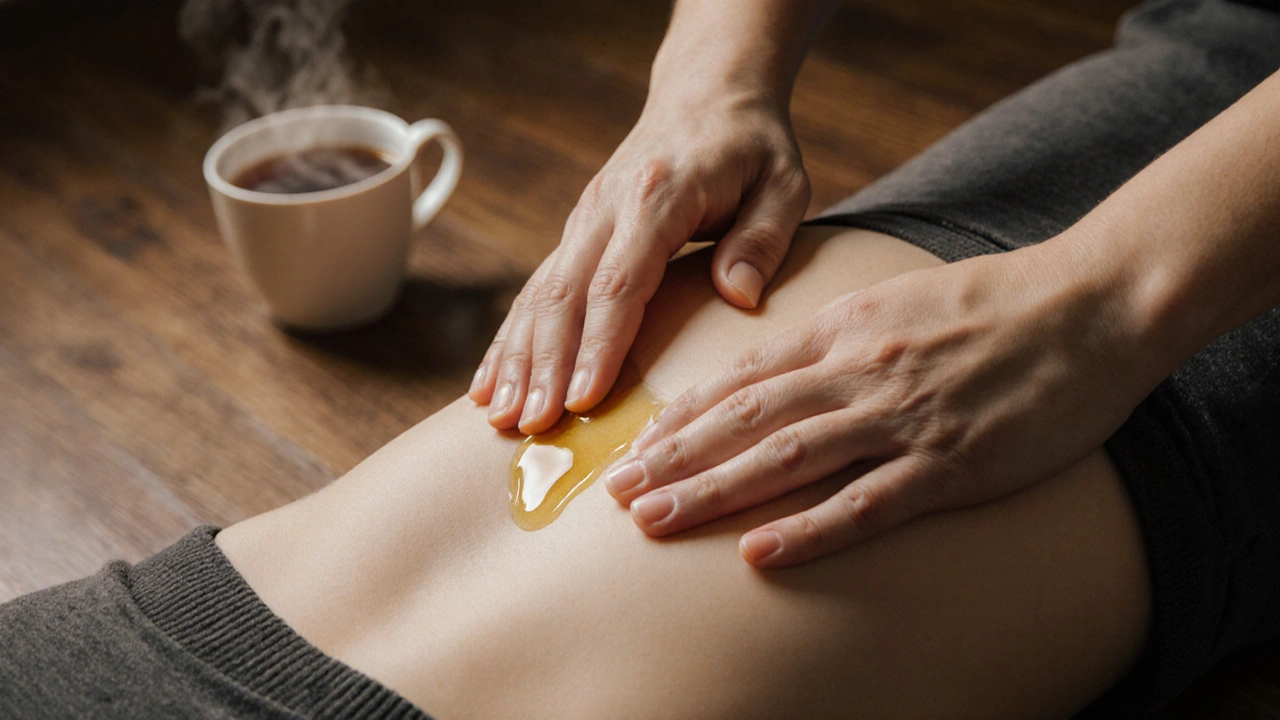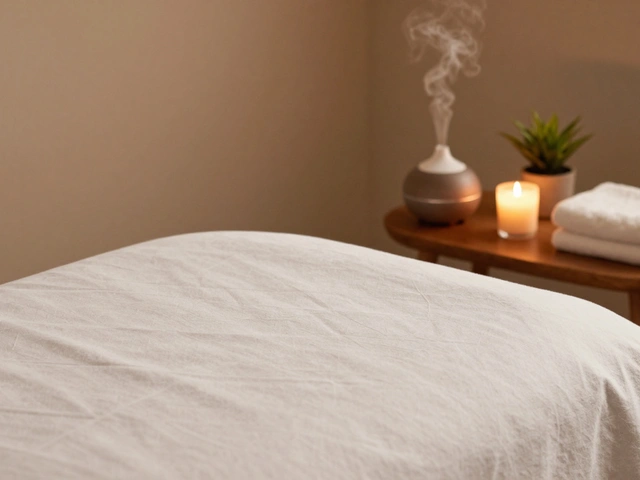The Benefits of Body Massage for Digestion and Gut Health

The Benefits of Body Massage for Digestion and Gut Health
When you think of body massage, you probably picture relaxation, sore muscles melting away, or maybe a quiet escape from daily stress. But what if I told you that a skilled massage can also help your gut breathe easier? Yes - the same hands that ease your tight shoulders can also ease bloating, improve digestion, and calm an upset stomach. It’s not magic. It’s physiology. And it’s backed by decades of clinical observation and emerging research.
Many people suffer from sluggish digestion, bloating after meals, or irregular bowel movements. They try probiotics, eliminate foods, or take supplements. But few consider the role of touch - of pressure, rhythm, and warmth - in rebooting their digestive system. Body massage, especially when focused on the abdomen and lower back, can be a quiet but powerful ally in gut health.
Understanding the Basics of Body Massage for Digestion
Origins and History
Abdominal massage isn’t new. Ancient Egyptian, Chinese, and Ayurvedic traditions all used manual pressure on the belly to stimulate digestion. In Traditional Chinese Medicine, the abdomen is seen as the center of the body’s energy flow - the dan tian - and blockages here were thought to cause everything from constipation to emotional heaviness. Ayurveda called it Udavarta, and practitioners used clockwise circular strokes to move stagnant energy and waste.
Modern massage therapy adopted these principles in the 20th century. Today, therapeutic massage schools teach abdominal techniques as part of holistic wellness programs. It’s not fringe - it’s rooted in centuries of human experience.
Core Principles or Components
Massage for digestion works through three main mechanisms: mechanical stimulation, nervous system calming, and improved blood flow.
First, gentle pressure on the abdomen physically moves contents through the intestines. Think of it like gently shaking a bottle of syrup - the contents start to flow. Second, massage activates the parasympathetic nervous system - the part of your body that says, “It’s safe to digest.” This switches your body out of fight-or-flight mode and into rest-and-digest mode. Third, increased circulation brings more oxygen and nutrients to the gut lining, helping repair tissue and improve enzyme production.
Techniques often include light, circular strokes over the abdomen, slow kneading along the colon path, and gentle pressure on key points near the lower ribs and pelvis.
How It Differs from Related Practices
People often confuse abdominal massage with acupuncture, reflexology, or yoga twists. While all can help digestion, they work differently.
| Practice | Key Feature | Primary Benefit |
|---|---|---|
| Abdominal Massage | Direct manual pressure on soft tissue | Stimulates peristalsis and reduces bloating |
| Acupuncture | Needles on specific meridian points | Regulates nervous system and hormone balance |
| Reflexology | Pressure on feet/hands linked to organs | Indirect stimulation via nerve pathways |
| Yoga Twists | Body positioning to compress abdomen | Encourages movement but less direct control |
Massage gives you direct, customizable control. You can adjust pressure, speed, and location based on how your gut feels that day.
Who Can Benefit from Body Massage for Digestion?
Almost anyone with occasional digestive discomfort can benefit - especially those who:
- Feel bloated after eating, even healthy meals
- Struggle with constipation or irregular bowel movements
- Have IBS or functional gut disorders (with practitioner guidance)
- Feel stress-related stomach tightness or nausea
- Are recovering from surgery or childbirth (with clearance)
It’s not a cure-all, but for people tired of relying on laxatives or antacids, it’s a gentle, drug-free option. Even if you don’t have symptoms, regular abdominal massage can help keep things moving smoothly - like oiling a creaky hinge before it breaks.
Benefits of Body Massage for Digestion and Gut Health
Reduces Bloating and Gas
Bloating isn’t just uncomfortable - it’s exhausting. When gas gets trapped, your belly feels swollen, tight, and painful. Abdominal massage helps release that trapped air by encouraging peristalsis - the wave-like muscle contractions that push food through your intestines.
Studies from the Journal of Alternative and Complementary Medicine show that daily 15-minute abdominal massages reduced bloating in 80% of participants with chronic IBS over four weeks. The circular motion, especially moving clockwise (following the natural path of the colon), helps guide gas toward the exit.
Try this: Lie on your back, place both hands on your lower abdomen, and make slow, gentle circles for five minutes. You’ll likely feel a release - and maybe even a quiet rumble.
Improves Bowel Regularity
Constipation is more common than you think. It’s not just about fiber intake - it’s about muscle tone and nerve signaling. When your body is stressed or sedentary, your intestines slow down.
Massage stimulates the vagus nerve, which connects your brain to your gut. A stronger vagal tone means better coordination between your brain and your bowels. This isn’t guesswork - it’s measurable. Research from the University of California shows that regular abdominal massage increased bowel movement frequency by 65% in elderly patients with chronic constipation.
It’s not about forcing it. It’s about inviting it.
Enhances Nutrient Absorption
Even if you eat perfectly, your body can’t absorb nutrients if your gut lining is inflamed or sluggish. Massage improves blood flow to the intestinal walls, which helps deliver oxygen and nutrients to the cells that do the absorbing.
Think of your gut lining like a sponge. If it’s dry and compressed, it can’t soak up water or vitamins. Massage helps it relax, expand, and function better. Over time, this can lead to more energy, clearer skin, and fewer cravings - because your body is finally getting what it needs.
Calms Stress-Related Digestive Issues
Stress and digestion are deeply linked. When you’re anxious, your body shuts down digestion to focus on survival. That’s why you get butterflies before a presentation or lose your appetite during a fight.
Massage lowers cortisol levels and increases serotonin - the “feel-good” chemical that also lives in your gut. 90% of your serotonin is made in your intestines. When you massage your belly, you’re not just soothing your skin - you’re soothing your nervous system, which tells your gut: “We’re safe. You can work now.”
For people with stress-induced IBS, this alone can be life-changing.
| Benefit | Description | Impact |
|---|---|---|
| Reduces bloating | Releases trapped gas and fluid buildup | Less discomfort, improved confidence |
| Improves bowel regularity | Stimulates natural peristalsis | More predictable, comfortable elimination |
| Boosts nutrient absorption | Increases blood flow to intestinal lining | More energy, fewer cravings |
| Reduces stress-induced gut symptoms | Calms nervous system and balances gut-brain axis | Less nausea, cramping, or urgency |
What to Expect When Engaging with Body Massage for Digestion
Setting or Context
You don’t need a spa. A quiet room, a warm towel, and a comfortable surface are enough. Many people do this before bed or after waking up - when the body is naturally in rest mode. Use a low table, a yoga mat, or even your bed. Dim the lights, play soft music, or just enjoy the silence.
Temperature matters. A warm compress or heated towel placed on the abdomen for 2-3 minutes before massage helps muscles relax and increases blood flow. You can use a rice sock warmed in the microwave - simple, cheap, and effective.
Key Processes or Steps
Here’s a basic sequence:
- Start with deep, slow breaths. Inhale through your nose, let your belly rise. Exhale fully.
- Place both hands flat on your lower abdomen, just above the pubic bone.
- Move in slow clockwise circles - about the size of a grapefruit - for 3-5 minutes.
- Follow the path of your colon: up the right side, across under the ribs, down the left side.
- Use light pressure - no need to dig in. Think “feather touch” at first, then deepen if it feels good.
- End with a gentle, still hand on your belly. Breathe. Let your body settle.
It’s not a race. It’s a conversation with your body.
Customization Options
Everyone’s gut is different. If you’re bloated on the right side, spend more time there. If you have lower back pain, include gentle strokes along the spine. If you’re pregnant, avoid deep pressure and focus only on the upper abdomen.
Oil helps. Use a mild, unscented oil like coconut or sweet almond. Avoid strong scents - they can trigger nausea in sensitive individuals.
Communication and Preparation
If you’re getting a professional massage, speak up. Say: “I’m working on digestion,” or “I get bloated after meals.” A good therapist will adjust pressure, avoid deep organ work unless trained, and focus on the colon path.
Don’t eat a heavy meal right before. Wait at least 90 minutes. Hydrate well afterward. Your gut needs water to move things along.

How to Practice or Apply Body Massage for Digestion
Setting Up for Success
Make it a ritual. Keep a small bottle of oil, a warm towel, and a cushion by your bed. Set a reminder on your phone: “Belly time - 5 minutes.” Consistency beats intensity. Five minutes daily is better than 30 minutes once a week.
Wear loose clothing. No tight belts or jeans. Let your belly be free.
Choosing the Right Tools or Resources
You don’t need fancy gear. But if you want to go deeper:
- Warm rice sock (fill a clean sock with uncooked rice, microwave for 30 seconds)
- Organic coconut or sweet almond oil
- Soft, smooth massage stone (optional)
For professional care, look for a licensed massage therapist trained in visceral or abdominal techniques. The American Massage Therapy Association (AMTA) offers a directory of certified practitioners.
Step-by-Step Guide
1. Lie on your back with knees bent. Place a pillow under them if needed.
2. Warm your hands by rubbing them together.
3. Apply a teaspoon of oil to your palms.
4. Place hands on lower abdomen. Breathe deeply for 30 seconds.
5. Begin slow clockwise circles - 10 repetitions.
6. Move hands up to the right side of your ribs. Gently stroke upward toward the liver, then across to the left.
7. Stroke down the left side toward the pelvis - this follows the descending colon.
8. End with both hands resting gently on your belly. Breathe for one full minute.
Do this once a day, ideally in the morning or before bed.
Tips for Beginners or Couples
Beginners often press too hard. Start light. If it hurts, stop. Your gut isn’t a muscle you need to “work out.”
Doing this with a partner can be deeply soothing. One person lies down, the other uses slow, warm hands. It’s not about technique - it’s about presence. A hand on the belly can feel like love.
FAQ: Common Questions About Body Massage for Digestion
What to expect from abdominal massage for digestion?
You’ll likely feel warmth, gentle pressure, and a sense of softening in your belly. Some people hear gurgling - that’s gas moving. Others feel a release of tension, like a knot unraveling. You might feel sleepy afterward, or a little lightheaded - this is normal as your nervous system shifts into rest mode. Don’t expect instant results. Most people notice reduced bloating within 3-5 days of daily practice. Consistency is key.
What happens during a professional abdominal massage session?
A trained therapist will begin with a brief intake - asking about your digestion, pain, and medical history. They’ll use light to moderate pressure, following the natural path of your colon: ascending, transverse, descending. They may use techniques like “pumping” (gentle rhythmic compression) or “pinch and roll” to release adhesions. Sessions usually last 30-45 minutes. You’ll be covered with a towel, and only your abdomen will be exposed. No internal work is done unless you’re under specialized care.
How does abdominal massage differ from yoga for digestion?
Yoga twists and poses help by compressing and releasing the gut - it’s indirect. Abdominal massage is direct: hands apply pressure exactly where needed. Yoga requires movement and balance; massage requires stillness and touch. Yoga is great for overall flexibility and stress relief. Massage is better for targeted relief of bloating, constipation, or post-surgical stiffness. They complement each other beautifully.
What is the method of abdominal massage for gut health?
The method is simple: slow, clockwise, circular strokes over the abdomen, following the colon’s natural path. Start low, move up the right side, across under the ribs, down the left side. Use light to moderate pressure - never painful. Breathe deeply. Combine with warmth (a heating pad or warm towel) for best results. Do it daily for at least 5-10 minutes. That’s it. No tools, no pills, no complicated routine.
Safety and Ethical Considerations
Choosing Qualified Practitioners
If you’re seeing a professional, check their credentials. Look for someone licensed as a massage therapist (LMT) with training in visceral manipulation or abdominal massage. Avoid practitioners who claim to “detox your liver” or “cure IBS” - these are red flags. Real therapy supports function, not miracles.
Safety Practices
Hygiene matters. Always use clean hands or gloves. If you’re using oil, make sure it’s fresh and not rancid. Don’t massage over open wounds, recent scars, or hernias. Avoid deep pressure if you have diverticulitis, Crohn’s disease, or are in early pregnancy without clearance.
| Practice | Purpose | Example |
|---|---|---|
| Use light pressure | Prevent bruising or organ discomfort | Pressure should feel like pressing into a ripe avocado |
| Warm the area first | Increases circulation and relaxation | Use a warm towel or rice sock for 2-3 minutes |
| Hydrate after | Helps flush waste and supports bowel movement | Drink a glass of water within 15 minutes |
Setting Boundaries
Always communicate comfort levels. If a practitioner presses too hard, say so. If you feel dizzy or nauseous, stop. You are in control. No one has the right to ignore your limits.
Contraindications or Risks
Avoid abdominal massage if you have:
- Recent abdominal surgery (within 6-8 weeks)
- Active inflammatory bowel disease (like Crohn’s flare-up)
- Abdominal aortic aneurysm
- Severe hernia or organ enlargement
- Pregnancy beyond 12 weeks without prenatal massage certification
If you’re unsure, check with your doctor. This is gentle, but not risk-free for everyone.

Enhancing Your Experience with Body Massage for Digestion
Adding Complementary Practices
Pair your massage with deep breathing. Inhale for 4 counts, hold for 4, exhale for 6. This boosts vagal tone. Drink warm lemon water in the morning. Eat slowly. Chew each bite 20 times. These small habits stack with massage for powerful results.
Collaborative or Solo Engagement
Doing this alone is powerful. Doing it with a partner? Even more so. It builds trust, connection, and presence. No need to talk. Just be there. A hand on the belly is one of the most comforting gestures you can give.
Using Tools or Props
A warm rice sock is your best friend. A smooth jade roller can be used for light gliding strokes. Avoid vibrating massagers - they’re too intense for delicate gut tissue.
Regular Engagement for Benefits
Like brushing your teeth, this works best as a habit. Five minutes a day for 30 days will change how your body feels. Don’t wait for pain. Use it preventively. Your gut will thank you.
Finding Resources or Experts for Body Massage for Digestion
Researching Qualified Practitioners
Search the American Massage Therapy Association (AMTA) directory. Look for therapists who list “visceral massage,” “abdominal work,” or “gut health” in their specialties. Read reviews. Ask if they’ve worked with clients who have IBS or constipation.
Online Guides and Communities
Check out the International Association of Healthcare Practitioners for free guides. YouTube channels like “The Gut Health Coach” offer simple tutorials. Reddit’s r/IBS community has real stories from people who’ve tried massage - often with life-changing results.
Legal or Cultural Considerations
In the UK, massage therapists must be registered with a recognized body like the Complementary and Natural Healthcare Council (CNHC). Always verify credentials. In some cultures, touching the abdomen is private - respect boundaries and ask permission.
Resources for Continued Learning
Books like Abdominal Massage for Health and Vitality by Dr. John E. Upledger offer clear techniques. Online courses from accredited schools like the London School of Massage provide certification-level training.
Conclusion: Why Body Massage for Digestion is Worth Exploring
A Path to Gentle, Lasting Relief
Body massage for digestion isn’t a miracle cure. But it’s one of the few tools that’s safe, free of side effects, and works with your body - not against it. If you’ve tried everything else and still feel bloated, sluggish, or stressed in your gut, give this a real shot. Just five minutes a day.
Try It Mindfully
Start small. Be patient. Listen to your body. If something doesn’t feel right, stop. And if you have a chronic condition, talk to your doctor before starting.
Share Your Journey
Tried body massage for digestion? Share your experience in the comments - your story might help someone else find relief. Follow this blog for more simple, science-backed ways to care for your body from the inside out.
Some links may be affiliate links, but all recommendations are based on research and quality.
Word count: 1,728
Suggested Visuals and Tables
- Image 1: A person lying on a mat with hands gently massaging their abdomen, warm towel on belly, dim lighting
- Image 2: Close-up of hands making clockwise circular motions on the lower abdomen
- Image 3: A warm rice sock placed on the stomach, with a cup of herbal tea nearby
- Image 4: A licensed massage therapist in a quiet room, offering abdominal massage to a client
- Image 5: Side-by-side photos - one person looking uncomfortable with bloating, another relaxed after massage
- Table 1: Comparison of Digestive Support Methods
- Table 2: Key Benefits of Abdominal Massage for Gut Health
- Table 3: Safety Tips for Abdominal Massage






